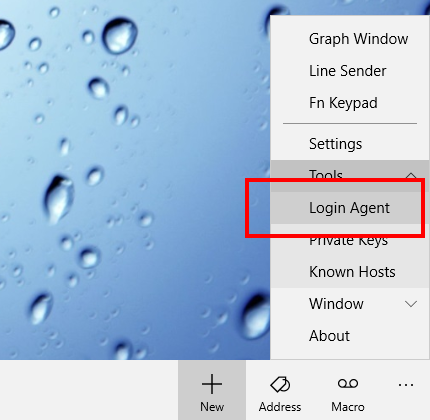STEP 1 Install Token2Shell/MD
Token2Shell/MD is readily available in Windows Store. Thus when you want to install Token2Shell/MD, simply open Windows Store app and search for "Token2Shell/MD".

You can also click the following link to directly open Token2Shell/MD app page in Windows Store.
Once you reached Token2Shell/MD app page from Windows Store app, click the price of Token2Shell/MD or "Free trial" button to begin installing Token2Shell/MD.

STEP 2 Start Token2Shell/MD
When you launch Token2Shell/MD, it first shows its own "desktop" with a randomly selected background image. In order to make a connection to a server, you need to open a terminal window on this desktop.

Opening More Desktops
You can have multiple desktops of Token2Shell/MD. In order to open a new desktop, you can use the following methods:
- Select [ ⋯ (See more) ] » [ Window ] » New Desktop menu from the bottom command bar

- Tap "New" button from the bottom command bar while holding a SHIFT key (this also opens a new terminal window from the newly created desktop)

- Drag-and-drop a terminal window outside of Token2Shell/MD desktop
- Tap Token2Shell/MD taskbar button while holding a SHIFT key

- Tap a pinned Token2Shell/MD tile (address book entry or folder) from Start menu while holding a SHIFT key

Changing Desktop Background
The options for changing the desktop background image are available under [ ⋯ (See more) ] » [ Tools ] » Settings » general.

STEP 3 Open a Terminal Window
A terminal window can be opened in several ways:
- Tap "New" button from the bottom command bar (If you hold a SHIFT key while tapping or clicking the New button, Token2Shell/MD opens a new terminal window on a new desktop.)

- Press ALT+N
- Double-tap on the desktop
- Tap an entry from Address Book side-panel (ALT+A)

- Tap "Connect" button from the bottom command bar of the Address Book management page.

Window Management
In order to move a window within Token2Shell/MD desktop, simply use its title bar. When you drag the main title text area of the title bar, you can freely move the window.

For a terminal window, dragging the accent colored header area initiates "drag-and-drop" mode. While in this drag-and-drop mode, you can drop the selected terminal window to another Token2Shell/MD desktop, or create a new desktop and move the terminal window to it.

While dragging a window, you can swipe it outside of the desktop. In such situation, Token2Shell/MD puts the selected window in "Auto Hide" mode. In this mode, Token2Shell/MD automatically shows the window if it gets a keyboard input focus, and hides it when it loses the focus.
When you need to fully bring a window into the current desktop, you can tap its corresponding listing item from the bottom command bar.
STEP 4 Connect to a Server
When you open an empty terminal window, it first shows "Quick Connect" popup (ALT+D). Quick Connect popup can be used to create a connection without creating an Address Book entry.

In the server address text box of a Quick Connect popup, you can also enter a URL-style server address path. It overrides currently selected options such as "protocol" and/or "port number". For example, if you want to make an SSH connection to a server "192.168.1.101" at port number "999" using an user ID "abcid", you can enter "ssh://abcid@192.168.1.101:999".
Token2Shell/MD currently supports the following connection protocol type prefixes:
| ab:// | Address Book Entry |
| ssh:// | SSH |
| telnet:// | Telnet |
| tcp:// | TCP Direct |
Home Folder
All essential configurations including Address Book entries and private key files are stored under a folder named "Token2Shell" that is referred to as a "Home Folder" in Token2Shell/MD. When you first install Token2Shell/MD, this folder is set to its private app data folder. However, you can freely change it to any folder via [ ⋯ (See more) ] » [ Tools ] » Settings » general » home folder option.

Token2Shell/MD also supports using Address Book entries, RSA/DSA private keys, keyboard mappings and other essential configuration files from Token2Shell for Windows. So, if you're already a Token2Shell for Windows user, simply copy back and forth the Home Folder to synchronize the configuration.
(Please note that if you edit an address book entry that was created in Token2Shell for Windows, some settings may get lost as Token2Shell/MD does not support the same set of options.)
Address Book
Token2Shell/MD includes Address Book for managing servers. Each server entry can have its own connection settings including Auto Login and Startup Macro. You can also assign different screen settings such as text and background colors.
For quick access to Address Book entries, you can use the Address Book side-panel.

When you want to move Address Book entries to a new folder or mange them in full window, tap "Manage" button on the Address Book side-panel.

Login Agent
When Login Agent is enabled you don't need to enter your password repeatedly to log into the same server. Login Agent automatically caches login credentials and discards them when Token2Shell/MD is closed.

A private key is also cached once it's used for logging into a server (Private Key User Authentication). If you want to pre-load a private key, use [ + (Add Private Key) ] button in Login Agent.

Agent Forwarding is also supported for SSH connections with RSA/DSA public key user authentication.
We always try to design features in our apps as intuitive and straightforward as possible. However, if you're having any problem using or finding features in Token2Shell/MD, please don't hesitate to contact us. We are here to help you!


